tire size MERCEDES-BENZ E-CLASS SEDAN 2018 Owner's Manual
[x] Cancel search | Manufacturer: MERCEDES-BENZ, Model Year: 2018, Model line: E-CLASS SEDAN, Model: MERCEDES-BENZ E-CLASS SEDAN 2018Pages: 498, PDF Size: 6.54 MB
Page 336 of 498

Emergency
Re moving the saf etyv est
The saf etyv ests ar elocated in thes afet yv est
compartments in thed rive r's and front
passenger door stowagec ompartments.
#To remo ve:pull ou tsafet yj acketb ag 1 by
loop 2.
#Open saf etyv estb ag 1 and pull out the
saf etyv est.
% Ther earealso saf etyv estc ompart ments in
th er ear door stowagec ompartment sin
whic hsafet yv ests can be stowed.
1Maximum number of washes
2Maximum wash temp erature
3Do no tbleach
4Do no tiro n
5Do no tuse alaundr ydryer
6Do no tdry-clean
7Thi sisac lass2jacket The
requ irements defined bythel egal standard
ar eo nly fulfille difthe saf etyv estist he cor rect
size and is fully closed.
Re place thes afet yv estif:
Rit is damaged or dir tonthereflectiv estrips
cannol onger be remo ved
Rthem aximum number of washes is exceeded
Rthef luorescence of thes afet yv esth as faded
Flat tire
Note sonf lat tires
&
WARNING Risk of accident duetoaf lat
tire
Af lat tir eseve rely affects thed riving charac‐
te rist ics as well as thes teering and braking
of thev ehicle.
Ti re sw ithout run-flat characteristics:
#Do no tdrive on wit haflat tire.
#Chang ethe flat tir eimmediatel ywith
th ee mer gency spa rewheel or spare
334
Breakdown assis tance
Page 360 of 498
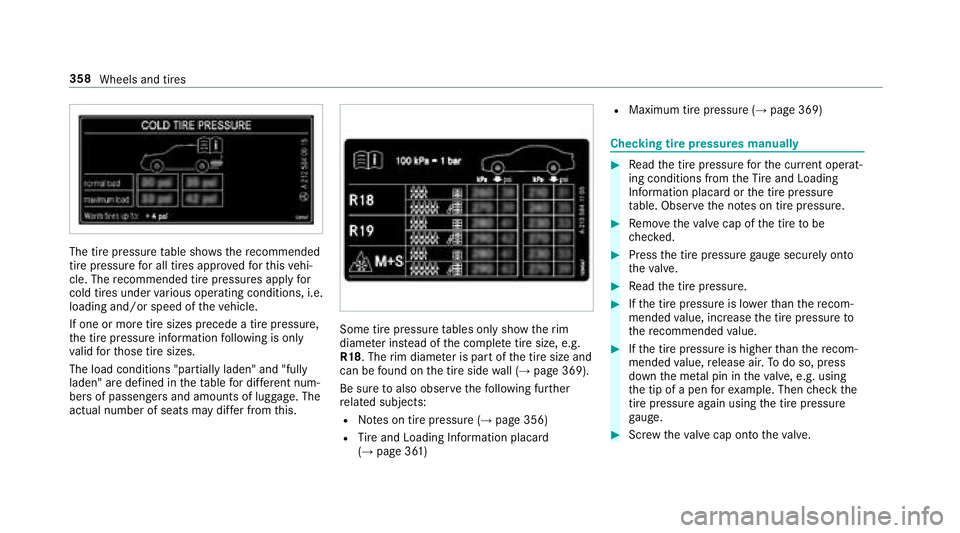
The tirepressur etable sho ws therecommended
tir ep ressur efor all tires appr ovedfor this vehi‐
cle. The recommended tir epressures apply for
cold tires under various operating conditions, i.e.
loading and/or speed of thev ehicle.
If one or mor etires izes precede atirep ressure,
th et irep ressur einformation following is only
va lid fort hose tir esizes.
The load conditions "partially laden" and "fully
laden" ar edefined in thet able ford iffe re nt num‐
be rs of passenger sand amounts of luggage. The
actual number of seats ma ydiffe rf romt his.
Some tir epressur etables onl yshowt he rim
diame teri ns tead of thec omple tetires ize, e.g.
R18 .The rimd iame terisp artoft he tir esize and
can be found on thet ires ide wall (
→pag e369).
Be sur etoalso observ ethe following fur ther
re lated subjects:
RNo tesont irep ressur e(→page356)
RTire and Loading Info rmatio nplacard
(→pag e361)
RMaximum tir epressur e(→page369)
Checking tir epressure smanually
#Read thet irep ressur efor thec urrent operat‐
ing conditions from theT irea nd Loading
Info rmatio nplacar dort he tirepressure
ta ble. Obser vethen otes on tir epressure.
#Re mo vethev alvec ap of thet iretob e
ch ecked.
#Press thet irep ressur egaug esecurel yonto
th ev alve.
#Read thet irep ressure.
#Ifth et irep ressur eisl owerthan ther ecom‐
mended value, inc rease thet irep ressur eto
th er ecommende dvalue.
#Ifth et irep ressur eish igher than ther ecom‐
mended value, release air .Todos o, press
down them etal pin in thev alve, e.g. using
th et ip of apen fore xamp le. Then checkt he
tir ep ressur eagain usingt he tirepressure
ga uge.
#Sc rewt he valvec ap ont othe valve.
358
Wheels and tires
Page 361 of 498
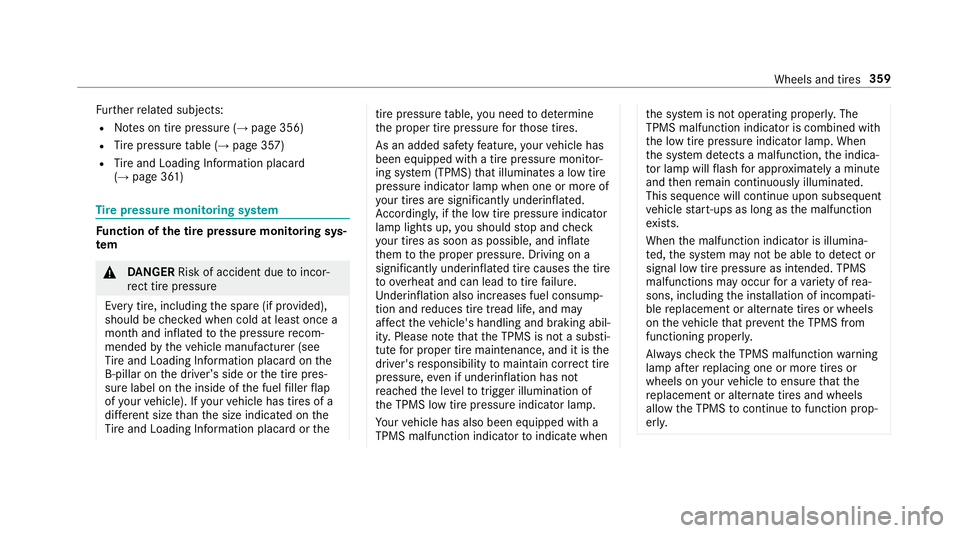
Further related subjects:
RNo tesont irep ressur e(→page356)
RTire pressur etable (→pag e357)
RTire and Loading Info rmatio nplacard
(→pag e361)
Tire pressur emonitoring sy stem
Fu nction of thet irep ressur emonitoring sys‐
te m
&
DANG ER Risk of accidentd uetoincor‐
re ct tir epressure
Ever ytire, including thes par e(if pr ovided),
should be checkedw hen cold at leas toncea
mont hand inflated tothep ressur erecom‐
mended bythev ehicle manufacturer (see
Ti re and Loading Info rmatio nplacar dont he
B-pi llaronthed rive r’ss ide or thet irep res‐
sur elabel on thei nside of thef uel filler flap
of your vehicle). If your vehicle has tires of a
dif fere nt size than thes ize indicated on the
Ti re and Loading Info rmatio nplacar dort he
tirep ressur etable, youn eedtod etermine
th ep roper tir epressur efor those tires.
As an added saf etyf eature, your vehicle has
been equipped wit hatirep ressur emonitor‐
ing sy stem (TPMS) that illuminates alow tire
pressur eindicator lam pwhen oneorm oreo f
yo ur tires ar esignif icantl yunderinflated.
Ac cordingly ,ifthe lo wtirep ressur eindicator
lam plights up, yous hould stop and check
yo ur tires as soonasp ossible, and inflate
th em tothep roper pressure. Driving on a
significantly underinflated tir ecauses thet ire
to ove rheat and can lead totiref ailure.
Und erinflation also increases fuel consump‐
tion and reduces tir etread life, and may
af fect thev ehicle's handling and braking abil‐
ity .P lease no tethat theT PMS is no tasubsti‐
tut efor proper tir emaintenance, and it is the
driver's responsibility tomaintain cor rect tire
pressure, evenifu nderinflatio nhasnot
re ached thel evel to trig gerillumination of
th eT PMS lo wtirep ressur eindicator lamp.
Yo ur vehicle has also been equipped wit ha
TPMS malfunction indicator toindicat ewhenthes ystemisn otoperating properly .The
TPMS malfunction indicator is combined with
th el ow tirep ressur eindicator lamp. When
th es ystemd etects amalfunction, thei ndica‐
to rlamp willf lashfora pproxima tely am inute
and then remain continuously illumina ted.
This sequence will continue upon subsequent
ve hicle start-ups as longast he malfunction
ex ists.
When them alfunction indicator is illumina‐
te d, thes ystem ma ynotbe able todetect or
signal lo wtirep ressur easi ntended. TPMS
malfunctions ma yoccurf orav ariety of rea‐
sons, includingt he installation of incompati‐
ble replacementora lternatetires or wheels
on thev ehicle that pr eventtheT PMS from
functioning properly.
Alw aysc hec kthe TPMS malfunction warning
lam pafter replacing one or mor etires or
wheels on your vehicle toensur ethat the
re placemen toralternat etires and wheels
allo wthe TPMS tocontinu etofunction prop‐
er ly.
Wheels and tires 359
Page 365 of 498
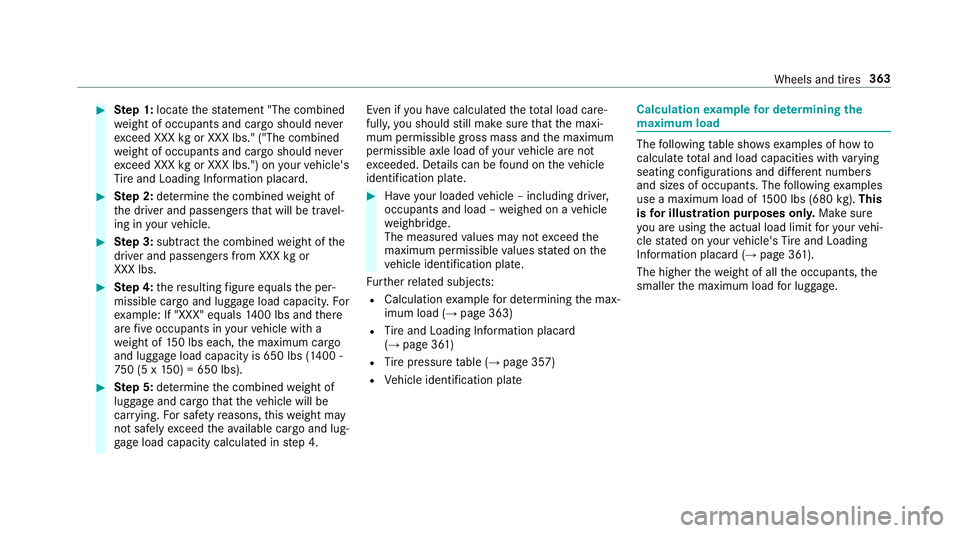
#Step1:loca tethes tatement" The combined
we ight of occupant sand cargo should ne ver
exc eed XXX kgor XXX lbs." ("The combined
we ight of occupant sand cargo should ne ver
exc eed XXX kgor XXX lbs.") on your vehicle's
Ti re and Loading Info rmatio nplacard.
#Ste p2:de term ine thec ombined weight of
th ed rive ra nd passenger sthat will be tra vel‐
ing in your vehicle.
#Ste p3:subtract thec ombined weight of the
driver and passenger sfromX XXkgor
XXX lbs.
#Ste p4:th er esulting figur eequals thep er‐
missible cargo and luggag eload capacity .For
ex ample: If "XXX"e quals 1400 lbs and there
ar ef iveo ccupantsiny ourvehicle wit ha
we ight of 150lbs each, them aximum cargo
and luggag eload capacity is 650 lbs (1400 -
75 0(5x1 50)= 650 lbs).
#Step5:de term ine thec ombined weight of
luggag eand cargo that thev ehicle will be
car rying. Fors afet yr easons, this we ight may
no ts afel yexceed thea vailable cargo and lug‐
ga ge load capacity calculated in step 4. Even if
youh avec alculated thet otal load care‐
full y,yo us hould still mak esuret hat them axi‐
mum permissible gross mass and them aximum
permissible axle load of your vehicle ar enot
exc eeded. De tails can be found on thev ehicle
identification plate.
#Ha ve your loaded vehicle –including driver,
occupants and load –weighed on avehicle
we ighbridge.
The measured values ma ynotexc eed the
maximu mpermissible values stated on the
ve hicle identification plate.
Fu rther related subjects:
RCalculation example ford eterminingt he max‐
imum load (→pag e363)
RTire and Loading Info rmatio nplacard
(→pag e361)
RTire pressur etable (→pag e357)
RVehicle identification plate
Calculation example ford eter mi ning the
ma ximum load
The following table sho wsexamples of ho wto
calculat etotal and load capacities wit hvarying
seatin gconfigurations and dif fere nt numbe rs
and sizes of occupants. The following examples
use amaximum load of 1500 lbs (680 kg).This
is fori llustratio npurposes on ly.Mak esure
yo ua reusingt he actual load limit fory our vehi‐
cle stated on your vehicle's Tire and Loading
Info rmatio nplacar d(
→page361).
The higher thew eight of all theo ccupants, the
smaller them aximum load forl ug gage .
Wheels and tires 363
Page 368 of 498
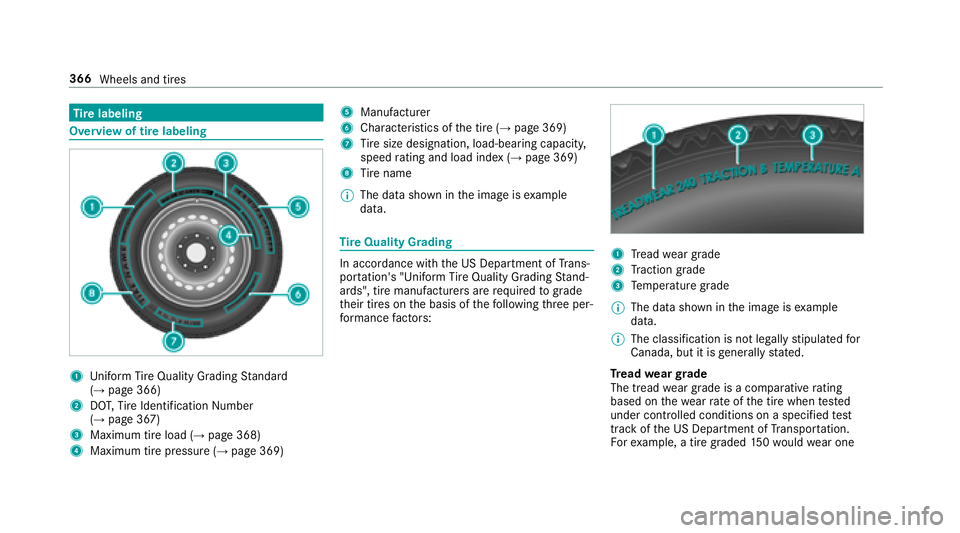
Tire labeling
Overvie woftirel abeling
1Uni form Ti reQuality Grading Standard
(→pag e366)
2DO T,Tire Identification Number
(→pag e367)
3Maximumt irel oad(→pag e368)
4Maximumt irep ressure (→page369)
5Manufacturer
6Characteristics of thet ire(→pag e369)
7Tire size designation, load-beari ng capacity,
speed rating and load ind ex(→pag e369)
8Tire name
% The da tashown in thei mag eise xamp le
data.
Ti re Quality Grading
In accordance wit hthe US Department of Trans‐
por tation's "Unifo rm TireQuality Grading Stand‐
ards", tir emanufacturer sare re quired tograde
th eir tires on theb asis of thef ollowing thre ep er‐
fo rm anc efactors:1Tread weargrade
2Traction grade
3Te mp eratur egrade
% The dat ashown in thei mag eise xamp le
data.
% The classification is no tlegall ystipulated for
Canada, but it is general lystated.
Tr ead weargrade
The tread wear grade is acomparativ erating
based on thew ear rate ofthet irew hen tested
under controlled conditions on aspecified test
trac koft he US Department of Transpor tation.
Fo re xamp le,atireg raded 150w ould wear one
366
Wheels and tires
Page 370 of 498

%The dat ashown in thei mag eise xamp le
data.
The TIN is aunique identification number to
identify tires and comprises thef ollowing:
RDO T(Department of Transport ation):tire
symbol mar ks1 indicatin gthat thet ire
complies wit hthe requ irements of theU S
Departmen tofTranspor tation.
RManufacturer identi fication code: manu‐
fa cturer identification code 2contains
de tails of thet irem anufacturer .New tires
ha ve ac odew itht wo symbols. Retreaded
tires ha veac odew ithf our symbols .Further
information on retreade dtires (
→page 374).
RTire size: identifier 3describes thet ire
size.
RTi re type code: tiret ypec ode 4can be
used bythem anufacturer as acode to
describe specific characteristic softhe tire.
RManufacturing date: manufacturing date
5 prov ides informatio nabout thea geof a
tire. The 1s tand 2nd position srepresent the
calenda rweek and the3 rdand 4t hpositions
st at et he year of manufactur e(e.g. "3208"
re present sthe 32nd week of 2008).
Information on them aximum tir eload
%
The dat ashown in thei mag eise xamp le
data.
Maximum tir eload 1isthem aximum permissi‐
ble weight forw hich thet ireisa pprove d.
Do no toverload thet ires by ex ceeding thes peci‐
fi ed load limit. The maximum permissible load
can be found on thev ehicle's Tire and Loading
Info rmatio nplacar dont he B-pillar on thed riv‐
er's side (
→pag e361).
Specifications form aximum tir epress ure
%
The da tashown in thei mag eise xamp le
data.
368 Wheels and tires
Page 371 of 498
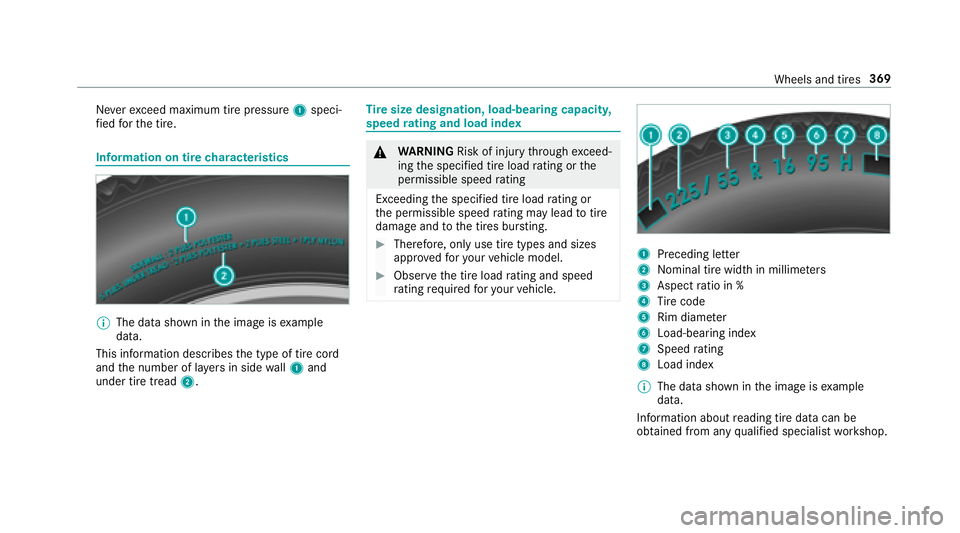
Nevere xceed maximum tir epressure 1speci‐
fi ed fort he tire.
Information on tir echaracteristics
%
The dat ashown in thei mag eise xamp le
data.
This information descri besthet ype of tir ecord
and then umber of la yers in side wall1 and
under tir etread 2.
Tire size designation, load-bearing capacity,
speed ratin ga nd load index
&
WARNING Risk of injury thro ugh exceed‐
ing thes pecified tir eload rating or the
permissible speed rating
Exceeding thes pecified tir eload rating or
th ep ermissible speed rating ma ylea dtot ire
damage andtothet ires bur sting.
#Therefore, onl yuse tir etypes and sizes
appr ovedfor your vehicle model.
#Obser vethet irel oad rating and speed
ra ting requ ired fory our vehicle.
1Preceding letter
2Nominal tir ewidthinm illimeters
3Aspect ratio in %
4Tire code
5Rimd iame ter
6Load-bearing index
7Speed rating
8Loadi ndex
% The dat ashown in thei mag eise xamp le
data.
Info rmatio nabout readingt ired atac an be
obtaine dfroma nyqualified specialis tworks hop.
Wheels and tires 369
Page 375 of 498
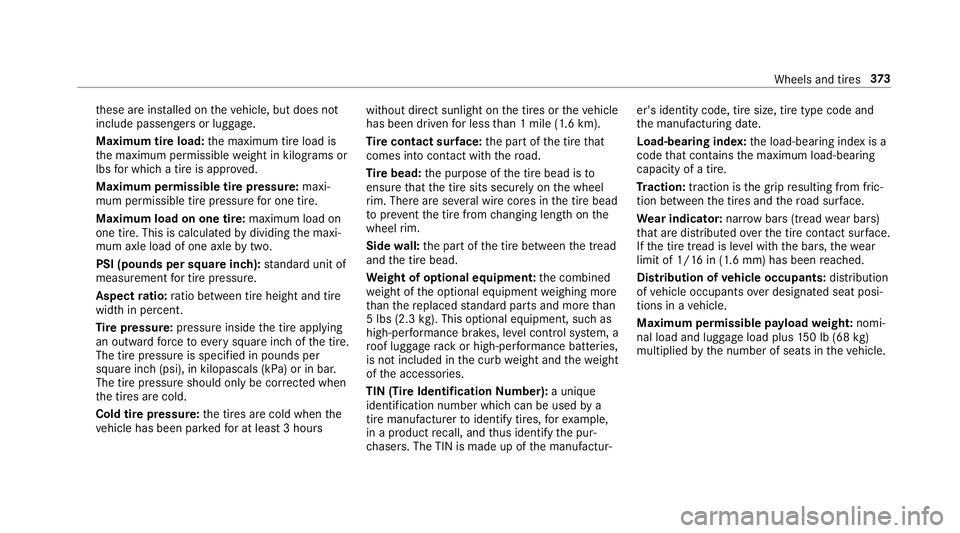
these ar einstalled on thev ehicle, but does not
include passenger sorluggage.
Maximum tir eload: them aximum tir eload is
th em aximum permissible weight in kilog rams or
lbs forw hich atireisa pprove d.
Maximum permissible tir epressure: maxi‐
mum permissible tir epressur efor one tire.
Maximum load on one tire: maximumloado n
one tire. This is calculated bydividing them axi‐
mum axle load of one axle bytwo.
PSI (pounds per squar einch) :st andar dunit of
measurementf or tirepressure .
Aspect ratio: ratio betwee ntire height and tire
widt hinp ercent.
Tir ep ress ure: pressur einside thet irea pplying
an outwar dforce toeve rysquar einc hoft he tire.
The tir epressur eiss pecified in pounds per
squar einc h( psi), in kilopascals (kPa) or in bar.
The tir epressur eshould onl ybecorrected when
th et ires ar ecold.
Cold tir epressure: thet ires ar ecold when the
ve hicle has been par kedf or at leas t3hours without direct sunlight on
thet ires or thev ehicle
has been driven forl ess than 1m ile (1.6 km).
Ti re contact sur face: thep artoft he tir ethat
comes int ocontact wi th theroad.
Ti re bead: thep urpose of thet ireb ead is to
ensur ethat thet ires its securel yonthe wheel
ri m. Ther eareseveralw irec ores in thet ireb ead
to preve ntthet iref romc hanging lengt honthe
whee lrim.
Side
w all: thep artoft he tir ebetwe en thet read
and thet ireb ead.
We ight of optiona lequ ipment: thec ombined
we ight of theo ptional equipment weighingm ore
th an ther eplaced standar dparts and mor ethan
5l bs (2. 3kg).T his optional equipment, suc has
high-per form anc ebrake s, le velc ontrol sy stem, a
ro of luggag erackorh igh-per form anc ebatte ries,
is no tincluded in thec urb weight and thew eight
of thea ccessories.
TIN (Tir eIdentification Number): auniqu e
identification number whic hcan be used bya
tir em anufactu rertoi dentify tires, fore xamp le,
in ap roductr ecall, and thus identif ythe pur‐
ch asers. The TIN is made up of them anufactur‐ er's identit
ycode, tir esize, tir etype code and
th em anufacturing date.
Load-bearing index: thel oad-bearing inde xisa
code that con tains them aximum load-bearing
capacity of atire.
Tr action: traction is theg ripr esulting from fric‐
tion between thet ires and ther oad sur face.
We ar indicator: narrow bars(tread wear bars)
th at ar edistributed overthe tir econtact surf ace.
If th et iret read is le velw itht he bars, thew ear
limit of 1/1 6in(1.6m m) has been reached.
Distribution of vehicl eoccupants: distribution
of vehicle occupants over designated seat posi‐
tion sinav ehicle.
Maximum permissible pa yload weight: nomi‐
nal load and luggag eload plus 150lb( 68kg
)
mu
ltipliedbyt he number of seats in thev ehicle.
Wheels and tires 37
3
Page 376 of 498

Changingawheel
Note sons electing, installing and replacing
tires
Mercedes -AMG vehicles: observethe no tesi n
th eS upplement .Otherwise, youm aynotrecog‐
niz ed angers.
Yo uc an ask fori nformation rega rding permitte d
wheel/tir ecombinations at an authorized
Mercedes-Ben zCenter.
&
WARNING Risk of accident duetoi ncor‐
re ct dimensions of wheelsa nd tires
If wheelsa nd tires of thew rong size are
ins talled, thew heel brakes or wheel suspen‐
sion components ma ybedamaged.
#Alwaysr eplace wheels and tires with
th ose that fulfill thes pecification sof
th eo riginal part.
When replacing wheels, mak esuretof itth e
cor rect:
RDesignation
RModel
Whenr eplacing tires, mak esuretoi nstallth e
cor rect:
RDesignation
RManufactu rer
RModel
&
WARNING Risk of injury thro ugh exceed‐
ing thes pecified tir eload rating or the
permissible speed rating
Exceeding thes pecified tir eload rating or
th ep ermissible speed rating ma ylea dtot ire
damage andtothet ires bur sting.
#Therefore, onl yuse tir etypes and sizes
appr ovedfor your vehicle model.
#Obser vethet irel oad rating and speed
ra ting requ ired fory our vehicle.
* NO
TEDama getovehicle and tires due to
non-app rove dt iret ypes and sizes
Fors afet yr easons, onl yuse wheels, tires
and accessories whichhave been appr oved
fo ry our vehicle byMercedes-Benz.
These tires ha vebeen speciall yadap tedf or
use wit hthe control sy stems, e.g. ABS or
ESP
®,a nd ar emarke dasf ollows:
RMO = Mercedes-BenzO riginal
RMOE = Mercedes-BenzO riginal Extended
(run-flat tires onl yfor cer tain wheels)
RMO1 = Mercedes-Benz Original (onl ycer‐
ta in AMG tires)
Cer tain characteristics, e.g .handling, vehicle
noise emissions or fuel consum ption, may
ot herwise be adversely af fected. In addition,
whe ndriving wi thaload, tir edimension var‐
iations could caus ethe tires tocome into
contact wi th thebody and axle components.
This could result in damag etothe tires or the
ve hicle.
37 4
Wheels and tires
Page 378 of 498
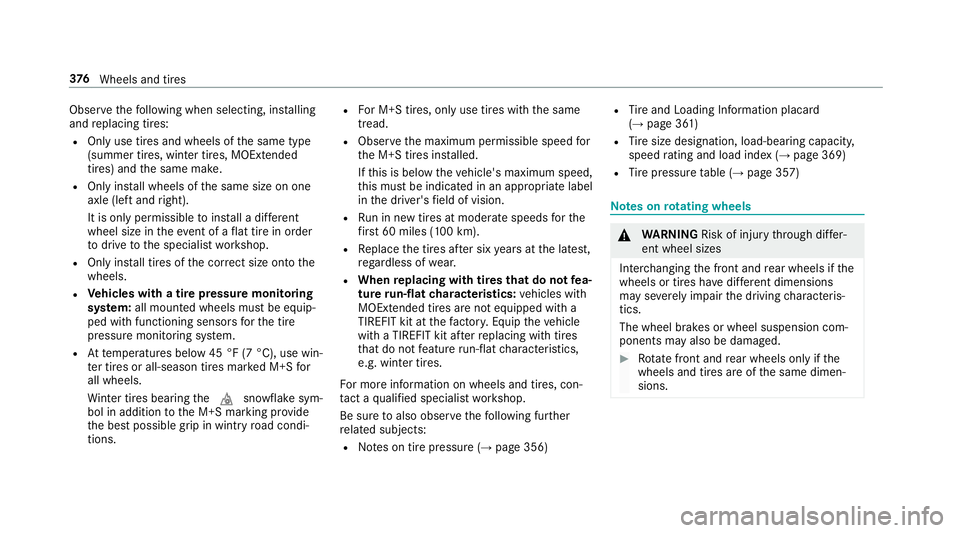
Observethef ollowing when selecting, ins talling
and replacing tires:
ROnl yuse tires and wheels of thes ame type
(summer tires, winter tires, MOEx tended
tires) and thes ame make.
ROnl yins tal lw heels of thes ame size on one
axle (lef tand right).
It is onl ypermissible toins tallad iffe re nt
whee lsizeint heeve nt of aflat tir eino rder
to driv etot he specialis tworks hop.
ROnl yins tall tires of thec orrect size ont othe
wheels.
RVe hicles with atirep ressur emonitoring
sy stem: all mounte dwheels mus tbeequip‐
ped wit hfunctioning sensor sfor thet ire
pressur emonitoring sy stem.
RAt temp eratures belo w45°F(7°C), use win‐
te rt ires or all-seaso ntires mar kedM +Sfor
all wheels.
Wi nter tires bearing thei snowflak esym‐
bol in addition totheM +S marking pr ovide
th eb estp ossible grip in wintr yroad condi‐
tions.
RFo rM +S tires, only use tires wit hthe same
tread.
RObser vethem aximum permissible speed for
th eM +S tires ins talled.
If th is is belo wthe vehicle's maximum speed,
th is mus tbeindicated in an appropriat elabel
in thed rive r's field of vision.
RRu ninn ewtires at moderat espeed sfor the
fi rs t60m iles (100km).
RReplace thet ires af ters ixyearsatt he latest,
re ga rdless of wear.
RWhen replacing with tires that do no tfea‐
tu re run-flat charac teristics:vehicles with
MOExtended tires ar enotequipped wit ha
TIREFIT kit at thef actor y.Equi pthe vehicle
wit haT IREFIT kit af terr eplacing wit htires
th at do no tfeatur erun- flat characteristics,
e.g .winter tires.
Fo rm orei nformation on wheels and tires, con‐
ta ct aq ualified specialis tworks hop.
Be sur etoalso observ ethe following fur ther
re lated subjects:
RNo tesont irep ressur e(→page356)
RTire and Loading Info rmatio nplacard
(→pag e361)
RTire size designation, load-beari ng capacity,
speed rating and load ind ex(→pag e369)
RTire pressur etable (→pag e357)
Note sonr otating wheels
&
WARNING Risk of injury thro ugh dif fer‐
ent wheels izes
Inter changing thef ront and rear wheels if the
wheels or tires ha vediffere nt dimensions
ma yseve rely impair thed riving characteris‐
tics.
The wheel brakes or wheel suspension com‐
ponent smayalso be damaged.
#Rotate front and rear wheels only ifth e
wheels and tires ar eofthe same dimen‐
sions.
37 6
Wheels and tires